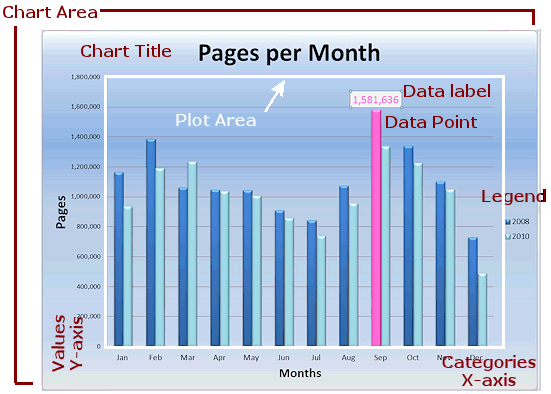Jan's Working with Numbers
Format: Chart
Once you have created a chart, you are not locked into your choices forever. You can change everything about the chart. Of course, if you have several changes, it might be faster to just start over.
The chart type determines the basic look of your chart - column, line, pie, bar, area, scatter, ring, doughnut, etc.


In addition the chart type will set font styles and sizes for titles and data labels, colors and patterns, grid lines, scale on the axes, and other features of your chart. The pre-defined chart types provide a very useful shortcut to chart design. You can customize any of features and save your design as a Custom type.
Commands for formatting charts are available on the Chart Tools ribbon tabs Design and Format. Excel 2007 and 2010 also have a Layout tab. Some commands are also on menus that pop up with a right-click on chart parts.
![]() Use the ribbon for most formatting. It
can be hard sometimes to click in just the right spot to get the menu you want. Use
the ribbon for the basics. That's the easy way!
Use the ribbon for most formatting. It
can be hard sometimes to click in just the right spot to get the menu you want. Use
the ribbon for the basics. That's the easy way!
Parts of a Chart
It might help to know the parts of a chart before you try to format one. Some types of charts do not have all of these parts. For example, a pie chart does not have axes.

| Plot area | where the data is actually pictured |
| Data series | the bars or dots or wedges that represent the values you are charting |
| Data point | a single value represented by a bar, dot, or wedge in the chart |
| Data label | a label for a bar or dot or wedge, displayed near it on the chart, showing the name, value, or the % of the whole |
| Axis | the vertical or horizontal edge of the chart that is marked off in even lengths |
| Data table | a table of the values plotted on the chart |
| Chart area | includes all of the chart parts - the plot area, the titles, the data table, legend, and background |
| Background | the color, pattern, or image behind the actual chart |
| Titles | the title for the whole chart and titles for each axis |
| Legend | shows what the colors or patterns on the chart represent |
| Chart tips | a screen tip that identifies the part your pointer is over. For a data point, the screen tip includes the name of the data series, the row label for the data point, and the data point's value. |
